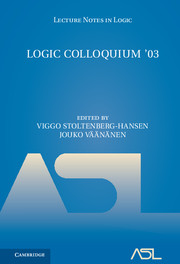Book contents
- Frontmatter
- Contents
- Introduction
- Colloquium Program
- TUTORIAL
- RESEARCH ARTICLES
- Indestructibility and strong compactness
- Some applications of regularmarkers
- Has the continuumhypothesis been settled?
- Geometry of interaction IV: the feedback equation
- On local modularity in homogeneous structures
- Descriptive set theory and uncountable model theory
- Decidable properties of logical calculi and of varieties of algebras
- Stabilization — an alternative to double-negation translation for classical natural deduction
- Definability and reducibility in higher types over the reals
- Predicativity problems in point-free topology
- Rank inequalities in the theory of differentially closed fields
- Consistency and games— in search of new combinatorial principles
- Realizability for constructive Zermelo-Fraenkel set theory
- On long EF-equivalence in non-isomorphic models
- The theory of is undecidable
- Cocovering and set forcing
- References
Descriptive set theory and uncountable model theory
from RESEARCH ARTICLES
Published online by Cambridge University Press: 30 March 2017
- Frontmatter
- Contents
- Introduction
- Colloquium Program
- TUTORIAL
- RESEARCH ARTICLES
- Indestructibility and strong compactness
- Some applications of regularmarkers
- Has the continuumhypothesis been settled?
- Geometry of interaction IV: the feedback equation
- On local modularity in homogeneous structures
- Descriptive set theory and uncountable model theory
- Decidable properties of logical calculi and of varieties of algebras
- Stabilization — an alternative to double-negation translation for classical natural deduction
- Definability and reducibility in higher types over the reals
- Predicativity problems in point-free topology
- Rank inequalities in the theory of differentially closed fields
- Consistency and games— in search of new combinatorial principles
- Realizability for constructive Zermelo-Fraenkel set theory
- On long EF-equivalence in non-isomorphic models
- The theory of is undecidable
- Cocovering and set forcing
- References
Summary
Abstract. We survey arguments in which methods of classical descriptive set theory are used to obtain information about uncountable models of theories in a countable language. Silver's theorem about Borel equivalence relations is used in the computation of the uncountable spectrum of certain theories and the fact that analytic sets have the property of Baire is useful in the analysis of stable, unsuperstable theories.
In the early days of the development of model theory it was considered natural and was certainly beneficial to assume that the theories under investigation were in a countable language. The primary advantage of this assumption was the presence of the Omitting Types Theorem of Grzegorczyk, Mostowski, and Ryll-Nardzewski [1], which generalized arguments of Henkin [3] and Orey [8]. Following this, Vaught [13] gave a very pleasing analysis of the class of countable models of such a theory. This led to Morley's categoricity theorem [7] for certain classes of uncountable models of theories in a countable language.
The landscape was completely altered by the subsequent work of Shelah (see e.g. [11]). He saw that the salient features of Morley's proof did not require the assumption of the language being countable. Indeed, many of notions that were central to Shelah's work, including unstability, the fcp, the independence property and the strict order property, are local. That is, a theory possesses such a property if and only if some formula has the property. Consequently, the total number of formulas in the language is not relevant. Still other notions, such as superstability, are not local but can be described in terms of countable fragments of the theory. That is, a theory of any cardinality is superstable if and only if all of its reducts to countable fragments of the theory are superstable. Using a vast collection of machinery, Shelah was able to answer literally hundreds of questions about the class of uncountablemodels of certain theories. Most of his arguments do not depend on the cardinality of the underlying language. In particular, he gave a proof of Ło's’ conjecture, that the analogue of Morley's theorem holds for theories in languages of any size. Somewhat curiously, whereas Shelah's methods were very good in classifying uncountable models of a theory, they had considerably less to say about the countable models of a theory.
- Type
- Chapter
- Information
- Logic Colloquium '03 , pp. 133 - 145Publisher: Cambridge University PressPrint publication year: 2006



